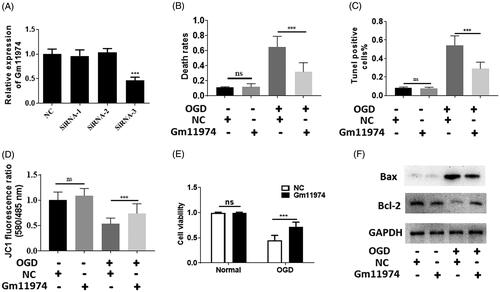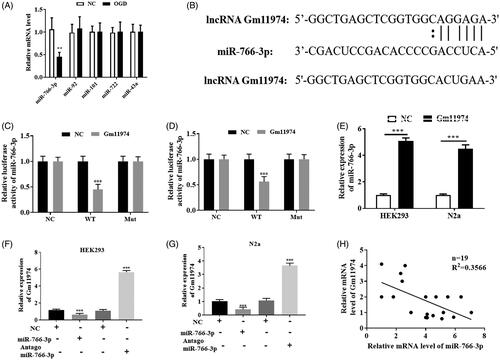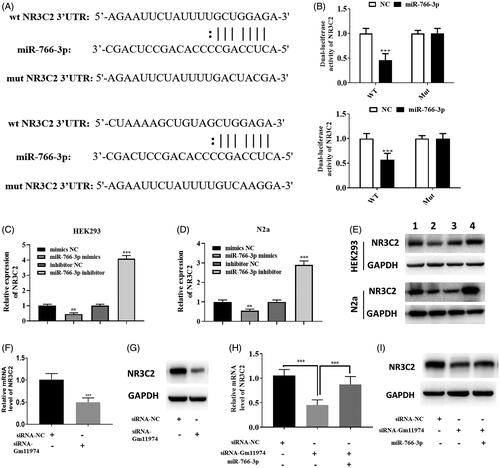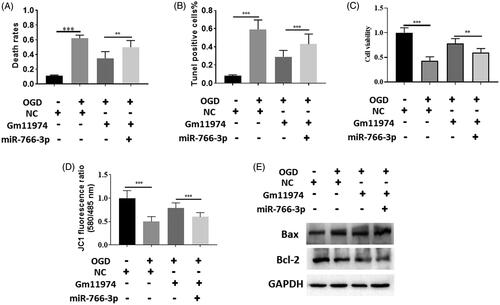Figures & data
Figure 1. preliminary analysis of lncRNA Gm11974. A. The cell viability was decreased with the time development of OGD exposure. B. The expression of lncRNA Gm11974 was increased with the time development of OGD exposure. C. lncRNA Gm11974 located in cytoplasm.

Figure 2. Function of lncRNA Gm11974 in cerebral ischemic reperfusion injury A. Knockdown of lncRNA Gm11974 was verified via real-time PCR. B. Knockdown of lncRNA Gm11974 significantly reduced the cell death rates. C. Tunel results suggested that knockdown of lncRNA Gm11974 significantly reduced the apoptosis cells. D. JC-1 results suggested that knockdown of lncRNA Gm11974 protect mitochondrial membrane potential. E. Cell viability revealed that knockdown of lncRNA Gm11974 significantly increased the cell viability. F Western blotting results revealed that Bax was decreased in the group of knockdowns of lncRNA Gm11974 and Bcl-2 was increased compared with NC group.

Figure 3. LncRNA Gm11974 negatively regulate miR-766-3p A. Bio-informatics analysis results showed that the potential binding miRNAs. B. The potential binding sequence between lncRNA Gm11974 and miR-766-3p. C. Dual-luciferase reporter assay revealed that lncRNA Gm11974 negatively regulate miR-766-3p in HEK293T cells. D. Dual-luciferase reporter assay revealed that lncRNA Gm11974 negatively regulate miR-766-3p in N2a cells. E. The expression of miR-766-3p was increased after knockdown of lncRNA Gm11974. F. Overexpression of miR-766-3p significantly decreased the expression of lncRNA Gm11974 in HEK293T cells and vice versa. G. Overexpression of miR-766-3p significantly decreased the expression of lncRNA Gm11974 in N2a cells and vice versa. H. LncRNA Gm11974 negatively regulate miR-766-3p.

Figure 4. MiRNA-766-3p negatively regulate NR3C2 A. The potential binding sequence between miR-766-3p and NR3C3. B. Dual-luciferase reporter assay suggested that miR-766-3p significantly reduced the activity of WT NR3C2 in HEK293T cells and N2a cells and had no changes in mut group. C. Overexpression of miR-766-3p significantly reduced the expression of NR3C2 and vice versa in HEK293T cells. D. Overexpression of miR-766-3p significantly reduced the expression of NR3C2 and vice versa in N2a cells. E. Overexpression of miR-766-3p significantly reduced the protein level of NR3C2 and vice versa in HEK293T and N2a cells via western blot. F. The expression of NR3C2 was decreased in the group of knockdowns of lncRNA Gm11974. G. The protein level of NR3C2 was decreased in the group of knockdowns of lncRNA Gm11974. H. Overexpression of miR-766-3p could rescued the effect of lncRNA Gm11974. I. Overexpression of miR-766-3p could rescued the effect of lncRNA Gm11974 via western blot.

Figure 5. LncRNA Gm11974/miR-766-3p/NR3C2 axis in cerebral ischemic reperfusion injury. A. Overexpression of miR-766-3p could increase the cell death rates compared with lncRNA Gm11974 group. B. Tunel assay showed that co-transfection of lncRNA Gm11974 and miR-766-3p could restored the effect of lncRNA Gm11974. C. Cell viability showed that co-transfection of lncRNA Gm11974 and miR-766-3p decreased the cell viability rate. D. Overexpression of miR-766-3p could rescued the effect of lncRNA Gm11974. E. Bax and Bcl-2 were detected via western blot.

